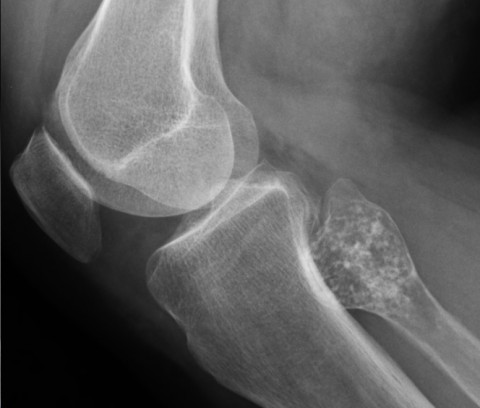Case Identification
Case ID Number
Tumor Type
Body region
Position within the bone
Periosteal reaction
Benign or Malignant
Clinical case information
Case presentation
This 58-year-old woman has six months of aching pain in the back of the right knee with no history of injury. X-rays show a lesion with a popcorn appearance.
Radiological findings:
plain x-rays show a slightly expansile radiolucent well-defined lesion in the right proximal fibula that measures about 40 x 55 mm. The proximal fibula has been slightly expanded and the cortex appears to be thinned. However there does not appear to be any breakout into the soft tissues. No periosteal reaction is present. There is a distinct flocculant punctate partially calcified matrix with ring and arc features, having the appearance of popcorn. No fracture is seen.
the MRI shows the lesion has very bright signal intensity on T2 type sequences and intermediate signal intensity on T1 type images with punctate low signal areas corresponding to the calcifications. The lesion completely occupies the expanded an enlarged proximal fibula. The MRI shows the expansion of the cortex and the thinning of the bone by the lesion, and confirms that there is no portion of the lesion that has broken out into the soft tissue.
the MRI shows the lesion has very bright signal intensity on T2 type sequences and intermediate signal intensity on T1 type images with punctate low signal areas corresponding to the calcifications. The lesion completely occupies the expanded an enlarged proximal fibula. The MRI shows the expansion of the cortex and the thinning of the bone by the lesion, and confirms that there is no portion of the lesion that has broken out into the soft tissue.
Laboratory results:
none
Differential Diagnosis
This lesion appears to have features consistent with cartilage. Diagnosis includes benign, low-grade malignant, or high-grade malignant cartilage lesions. There is additional concern when a cartilage lesion appears to be growing and expanding in an older adult.
Pathology results:
See images 1-6: 1)40X, from left to right: skeletal muscle, periosteum, thinned fibular cortex, impinged upon by low grade chondrosarcoma. 2),3) Similar 4)similar, high power 5) 40X, chondrosarcoma showing lobular growth pattern. The scalloped red material is bone, correlates with popcorn calcification on plain film. 6) 400x, Hypercellular grouping of atypical chondrocytes. The chondrocyte are atypical based on their clustering, hyperchromasia, and enlarged size.
Imagen

Case ID Number
Image Types
Image modality
Tumor Name
Example Image
yes
Tumor Type
Benign or Malignant
Body region
Bone name
Location in the bone
periosteal reaction
position within the bone
Tumor behavior
Tumor density









